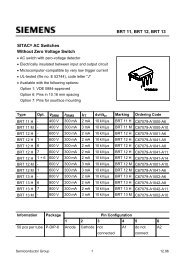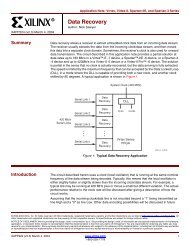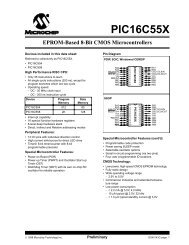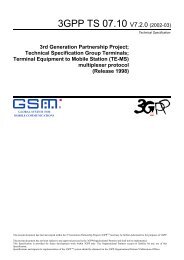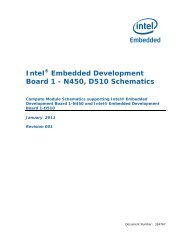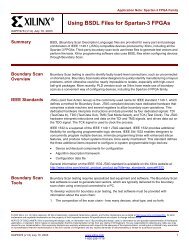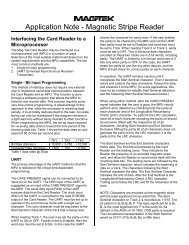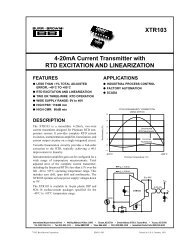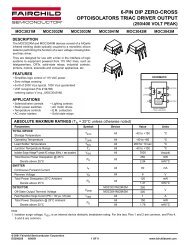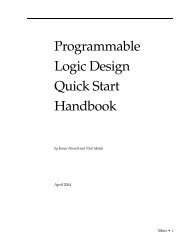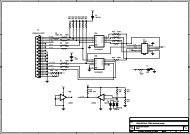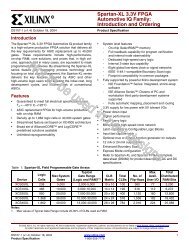PCF85163 Real-time clock and calendar - Digikey
PCF85163 Real-time clock and calendar - Digikey
PCF85163 Real-time clock and calendar - Digikey
You also want an ePaper? Increase the reach of your titles
YUMPU automatically turns print PDFs into web optimized ePapers that Google loves.
<strong>PCF85163</strong><strong>Real</strong>-<strong>time</strong> <strong>clock</strong> <strong>and</strong> <strong>calendar</strong>Rev. 2 — 28 July 2010Product data sheet1. General descriptionThe <strong>PCF85163</strong> is a CMOS 1 <strong>Real</strong>-Time Clock (RTC) <strong>and</strong> <strong>calendar</strong> optimized for low powerconsumption. A programmable <strong>clock</strong> output, interrupt output, <strong>and</strong> voltage-low detector arealso provided. All addresses <strong>and</strong> data are transferred serially via a two-line bidirectionalI 2 C-bus. Maximum bus speed is 400 kbit/s. The register address is incrementedautomatically after each written or read data byte.2. Features <strong>and</strong> benefits3. Applications• Provides year, month, day, weekday, hours, minutes, <strong>and</strong> seconds based on a32.768 kHz quartz crystal• Century flag• Clock operating voltage: 1.8 V to 5.5 V• Low backup current; typical 0.25 μA at V DD = 3.0 V <strong>and</strong> T amb =25°C• 400 kHz two-line I 2 C-bus interface (at V DD = 1.8 V to 5.5 V)• Programmable <strong>clock</strong> output for peripheral devices (32.768 kHz, 1.024 kHz, 32 Hz, <strong>and</strong>1Hz)• Alarm <strong>and</strong> <strong>time</strong>r functions• Internal Power-On Reset (POR)• I 2 C-bus slave address: read A3h <strong>and</strong> write A2h• Open-drain interrupt pin• Mobile telephones• Portable instruments• Electronic metering• Battery powered products1. The definition of the abbreviations <strong>and</strong> acronyms used in this data sheet can be found in Section 18.
NXP Semiconductors<strong>PCF85163</strong><strong>Real</strong>-<strong>time</strong> <strong>clock</strong> <strong>and</strong> <strong>calendar</strong>4. Ordering information5. MarkingTable 1.Type numberOrdering informationPackageName Description Version<strong>PCF85163</strong>T SO8 plastic small outline package; 8 leads;SOT96-1body width 3.9 mm<strong>PCF85163</strong>TS TSSOP8 plastic thin shrink small outline package;8 leads; body width 3 mmSOT505-1Table 2. Marking codesType numberMarking code<strong>PCF85163</strong>TPF85163<strong>PCF85163</strong>TS 85163<strong>PCF85163</strong> All information provided in this document is subject to legal disclaimers. © NXP B.V. 2010. All rights reserved.Product data sheet Rev. 2 — 28 July 2010 2 of 43
NXP Semiconductors<strong>PCF85163</strong><strong>Real</strong>-<strong>time</strong> <strong>clock</strong> <strong>and</strong> <strong>calendar</strong>6. Block diagramOSCIOSCO(1)OSCILLATOR32.768 kHzMONITORDIVIDER00hCONTROLControl_1CLOCK OUTCLKOUT01hControl_2POWER ONRESET0DhCLKOUT_controlTIME02hVL_seconds03hMinutesV DDV SS04h05h06hHoursDaysWeekdays07hCentury_monthsWATCHDOG08hYearsALARM FUNCTION09hMinute_alarm0AhHour_alarmSDASCLI 2 C-BUSINTERFACE0Bh0ChDay_alarmWeekday_alarmINTERRUPTINT<strong>PCF85163</strong>0Eh0FhTIMER FUNCTIONTimer_controlTimer013aaa038Fig 1.(1) C OSCO ; values see Table 30.Block diagram of <strong>PCF85163</strong><strong>PCF85163</strong> All information provided in this document is subject to legal disclaimers. © NXP B.V. 2010. All rights reserved.Product data sheet Rev. 2 — 28 July 2010 3 of 43
NXP Semiconductors<strong>PCF85163</strong><strong>Real</strong>-<strong>time</strong> <strong>clock</strong> <strong>and</strong> <strong>calendar</strong>7. Pinning information7.1 PinningOSCI18V DDOSCOINT23<strong>PCF85163</strong>T76CLKOUTSCLV SS45SDA013aaa039Fig 2.Top view. For mechanical details, see Figure 26Pin configuration for SO8 (<strong>PCF85163</strong>T)OSCI18V DDOSCOINT23<strong>PCF85163</strong>TS76CLKOUTSCLV SS45SDA013aaa040Fig 3.Top view. For mechanical details, see Figure 27Pin configuration for TSSOP8 (<strong>PCF85163</strong>TS)7.2 Pin descriptionTable 3. Pin descriptionSymbol Pin DescriptionSO8(<strong>PCF85163</strong>T)TSSOP8(<strong>PCF85163</strong>TS)OSCI 1 1 oscillator inputOSCO 2 2 oscillator outputINT 3 3 interrupt output (open-drain; active LOW)V SS 4 4 ground supply voltageSDA 5 5 serial data input <strong>and</strong> outputSCL 6 6 serial <strong>clock</strong> inputCLKOUT 7 7 <strong>clock</strong> output (open-drain)V DD 8 8 supply voltage<strong>PCF85163</strong> All information provided in this document is subject to legal disclaimers. © NXP B.V. 2010. All rights reserved.Product data sheet Rev. 2 — 28 July 2010 4 of 43
NXP Semiconductors<strong>PCF85163</strong><strong>Real</strong>-<strong>time</strong> <strong>clock</strong> <strong>and</strong> <strong>calendar</strong>8.2 Register organizationTable 4. Register overviewBit positions labeled as x are not relevant. Bit positions labeled with N should always be written with logic 0; if read, they couldbe either logic 0 or logic 1. After reset, all register are set according to Table 27.Address Register name Bit7 6 5 4 3 2 1 0Control <strong>and</strong> status registers00h Control_1 TEST1 N STOP N TESTC N N N01h Control_2 N N N TI_TP AF TF AIE TIETime <strong>and</strong> date registers02h VL_seconds VL SECONDS (0 to 59)03h Minutes x MINUTES (0 to 59)04h Hours x x HOURS (0 to 23)05h Days x x DAYS (1 to 31)06h Weekdays x x x x x WEEKDAYS (0 to 6)07h Century_months C x x MONTHS (1 to 12)08h Years YEARS (0 to 99)Alarm registers09h Minute_alarm AE_M MINUTE_ALARM (0 to 59)0Ah Hour_alarm AE_H x HOUR_ALARM (0 to 23)0Bh Day_alarm AE_D x DAY_ALARM (1 to 31)0Ch Weekday_alarm AE_W x x x x WEEKDAY_ALARM (0 to 6)CLKOUT control register0Dh CLKOUT_control FE x x x x x FD[1:0]Timer registers0Eh Timer_control TE x x x x x TD[1:0]0Fh Timer COUNTDOWN_TIMER[7:0]<strong>PCF85163</strong> All information provided in this document is subject to legal disclaimers. © NXP B.V. 2010. All rights reserved.Product data sheet Rev. 2 — 28 July 2010 6 of 43
NXP Semiconductors<strong>PCF85163</strong><strong>Real</strong>-<strong>time</strong> <strong>clock</strong> <strong>and</strong> <strong>calendar</strong>8.3.2.1 Interrupt outputBits TF <strong>and</strong> AF: When an alarm occurs, AF is set to logic 1. Similarly, at the end of a<strong>time</strong>r countdown, TF is set to logic 1. These bits maintain their value until overwrittenusing the interface. If both <strong>time</strong>r <strong>and</strong> alarm interrupts are required in the application, thesource of the interrupt can be determined by reading these bits. To prevent one flag beingoverwritten while clearing another, a logic AND is performed during a write access.TETF: TIMERto interface:read TFTI_TPTIEe.g. AIECOUNTDOWN COUNTERSETCLEARPULSEGENERATOR 20101TRIGGERfrom interface:clear TFCLEARINTset alarmflag AFAF: ALARMFLAGSETto interface:read AFAIEfrom interface:clear AFCLEAR013aaa087When bits TIE <strong>and</strong> AIE are disabled, pin INT will remain high-impedance.Fig 4.Interrupt schemeBits TIE <strong>and</strong> AIE: These bits activate or deactivate the generation of an interrupt whenTF or AF is asserted, respectively. The interrupt is the logical OR of these two conditionswhen both AIE <strong>and</strong> TIE are set.Countdown <strong>time</strong>r interrupts: The pulse generator for the countdown <strong>time</strong>r interrupt usesan internal <strong>clock</strong> <strong>and</strong> is dependent on the selected source <strong>clock</strong> for the countdown <strong>time</strong>r<strong>and</strong> on the countdown value n. As a consequence, the width of the interrupt pulse varies(see Table 7).Table 7. INT operation (bit TI_TP = 1) [1]Source <strong>clock</strong> (Hz)INT period (s)n=1 [2] n>1 [2]4096 1 ⁄ 8192 1 ⁄ 409664 1 ⁄ 128 1 ⁄ 641 1 ⁄ 64 1 ⁄ 641 ⁄ 60 1 ⁄ 64 1 ⁄ 64[1] TF <strong>and</strong> INT become active simultaneously.[2] n = loaded countdown value. Timer stops when n = 0.<strong>PCF85163</strong> All information provided in this document is subject to legal disclaimers. © NXP B.V. 2010. All rights reserved.Product data sheet Rev. 2 — 28 July 2010 8 of 43
NXP Semiconductors<strong>PCF85163</strong><strong>Real</strong>-<strong>time</strong> <strong>clock</strong> <strong>and</strong> <strong>calendar</strong>The VL flag is intended to detect the situation when V DD is decreasing slowly, for exampleunder battery operation. Should the oscillator stop or V DD reach V low before power isre-asserted, then the VL flag is set. This will indicate that the <strong>time</strong> may be corrupted.8.4.2 Register MinutesTable 10.8.4.3 Register Hours8.4.4 Register Days[1] The <strong>PCF85163</strong> compensates for leap years by adding a 29th day to February if the year counter contains avalue which is exactly divisible by 4, including the year 00.8.4.5 Register WeekdaysMinutes - minutes register (address 03h) bit descriptionBit Symbol Value Place value Description7 - - - unused6 to 4 MINUTES 0 to 5 ten’s place actual minutes coded in BCD format3 to 0 0 to 9 unit placeTable 11. Hours - hours register (address 04h) bit descriptionBit Symbol Value Place value Description7 to 6 - - - unused5 to 4 HOURS 0 to 2 ten’s place actual hours coded in BCD format3to0 0to9 unit placeTable 12.Days - days register (address 05h) bit descriptionBit Symbol Value Place value Description7 to 6 - - - unused5to4 DAYS [1] 0 to 3 ten’s place actual day coded in BCD format3to0 0to9 unit placeTable 13. Weekdays - weekdays register (address 06h) bit descriptionBit Symbol Value Description7 to 3 - - unused2 to 0 WEEKDAYS 0 to 6 actual weekday values, see Table 14<strong>PCF85163</strong> All information provided in this document is subject to legal disclaimers. © NXP B.V. 2010. All rights reserved.Product data sheet Rev. 2 — 28 July 2010 10 of 43
NXP Semiconductors<strong>PCF85163</strong><strong>Real</strong>-<strong>time</strong> <strong>clock</strong> <strong>and</strong> <strong>calendar</strong>Table 14. Weekday assignmentsDay [1]Bit2 1 0Sunday 0 0 0Monday 0 0 1Tuesday 0 1 0Wednesday 0 1 1Thursday 1 0 0Friday 1 0 1Saturday 1 1 0[1] Definition may be re-assigned by the user.8.4.6 Register Century_monthsTable 15. Century_months - century flag <strong>and</strong> months register (address 07h) bit descriptionBit Symbol Value Place value Description7 C [1] 0 [2] - indicates the century is x1 - indicates the century is x + 16 to 5 - - - unused4 MONTHS 0 to 1 ten’s place actual month coded in BCD format, see Table 163 to 0 0 to 9 unit place[1] This bit may be re-assigned by the user.[2] This bit is toggled when the register Years overflows from 99 to 00.Table 16. Month assignments in BCD formatMonth Upper-digit Digit (unit place)(ten’s place)Bit 4 Bit 3 Bit 2 Bit 1 Bit 0January 0 0 0 0 1February 0 0 0 1 0March 0 0 0 1 1April 0 0 1 0 0May 0 0 1 0 1June 0 0 1 1 0July 0 0 1 1 1August 0 1 0 0 0September 0 1 0 0 1October 1 0 0 0 0November 1 0 0 0 1December 1 0 0 1 0<strong>PCF85163</strong> All information provided in this document is subject to legal disclaimers. © NXP B.V. 2010. All rights reserved.Product data sheet Rev. 2 — 28 July 2010 11 of 43
NXP Semiconductors<strong>PCF85163</strong><strong>Real</strong>-<strong>time</strong> <strong>clock</strong> <strong>and</strong> <strong>calendar</strong>8.4.7 Register YearsTable 17.Years - years register (08h) bit descriptionBit Symbol Value Place value Description7 to 4 YEARS 0 to 9 ten’s place actual year coded in BCD format [1]3to0 0to9 unit place[1] When the register Years overflows from 99 to 00, the century bit C in the register Century_months istoggled.8.5 Setting <strong>and</strong> reading the <strong>time</strong>Figure 6 shows the data flow <strong>and</strong> data dependencies starting from the 1 Hz <strong>clock</strong> tick.1 Hz tickSECONDSMINUTESHOURSLEAP YEARCALCULATIONDAYSWEEKDAYMONTHSYEARSC013aaa092Fig 6.Data flow for the <strong>time</strong> functionDuring read/write operations, the <strong>time</strong> counting circuits (memory locations 02h through08h) are blocked.This prevents• Faulty reading of the <strong>clock</strong> <strong>and</strong> <strong>calendar</strong> during a carry condition• Incrementing the <strong>time</strong> registers, during the read cycleAfter this read/write access is completed, the <strong>time</strong> circuit is released again <strong>and</strong> anypending request to increment the <strong>time</strong> counters that occurred during the read access isserviced. A maximum of 1 request can be stored; therefore, all accesses must becompleted within 1 second (see Figure 7).<strong>PCF85163</strong> All information provided in this document is subject to legal disclaimers. © NXP B.V. 2010. All rights reserved.Product data sheet Rev. 2 — 28 July 2010 12 of 43
NXP Semiconductors<strong>PCF85163</strong><strong>Real</strong>-<strong>time</strong> <strong>clock</strong> <strong>and</strong> <strong>calendar</strong>t < 1 sSTARTSLAVE ADDRESS DATA DATASTOP013aaa215Fig 7.Access <strong>time</strong> for read/write operationsAs a consequence of this method, it is very important to make a read or write access inone go, that is, setting or reading seconds through to years should be made in one singleaccess. Failing to comply with this method could result in the <strong>time</strong> becoming corrupted.As an example, if the <strong>time</strong> (seconds through to hours) is set in one access <strong>and</strong> then in asecond access the date is set, it is possible that the <strong>time</strong> may increment between the twoaccesses. A similar problem exists when reading. A roll over may occur between readsthus giving the minutes from one moment <strong>and</strong> the hours from the next.Recommended method for reading the <strong>time</strong>:1. Send a START condition <strong>and</strong> the slave address for write (A2h).2. Set the address pointer to 2 (VL_seconds) by sending 02h.3. Send a RESTART condition or STOP followed by START.4. Send the slave address for read (A3h).5. Read VL_seconds.6. Read Minutes.7. Read Hours.8. Read Days.9. Read Weekdays.10. Read Century_months.11. Read Years.12. Send a STOP condition.<strong>PCF85163</strong> All information provided in this document is subject to legal disclaimers. © NXP B.V. 2010. All rights reserved.Product data sheet Rev. 2 — 28 July 2010 13 of 43
NXP Semiconductors<strong>PCF85163</strong><strong>Real</strong>-<strong>time</strong> <strong>clock</strong> <strong>and</strong> <strong>calendar</strong>8.6 Alarm registers8.6.1 Register Minute_alarmTable 18.[1] Default value.8.6.2 Register Hour_alarm[1] Default value.8.6.3 Register Day_alarm[1] Default value.8.6.4 Register Weekday_alarm[1] Default value.Minute_alarm - minute alarm register (address 09h) bit descriptionBit Symbol Value Place value Description7 AE_M 0 - minute alarm is enabled1 [1] - minute alarm is disabled6 to 4 MINUTE_ALARM 0 to 5 ten’s place minute alarm information coded in BCD3 to 0 0 to 9 unit placeformatTable 19.Hour_alarm - hour alarm register (address 0Ah) bit descriptionBit Symbol Value Place value Description7 AE_H 0 - hour alarm is enabled1 [1] - hour alarm is disabled6 - - - unused5 to 4 HOUR_ALARM 0 to 2 ten’s place hour alarm information coded in BCD3 to 0 0 to 9 unit placeformatTable 20.Day_alarm - day alarm register (address 0Bh) bit descriptionBit Symbol Value Place value Description7 AE_D 0 - day alarm is enabled1 [1] - day alarm is disabled6 - - - unused5 to 4 DAY_ALARM 0 to 3 ten’s place day alarm information coded in BCD3 to 0 0 to 9 unit placeformatTable 21.Weekday_alarm - weekday alarm register (address 0Ch) bit descriptionBit Symbol Value Description7 AE_W 0 weekday alarm is enabled1 [1] weekday alarm is disabled6 to 3 - - unused2 to 0 WEEKDAY_ALARM 0 to 6 weekday alarm information coded in BCD format<strong>PCF85163</strong> All information provided in this document is subject to legal disclaimers. © NXP B.V. 2010. All rights reserved.Product data sheet Rev. 2 — 28 July 2010 14 of 43
NXP Semiconductors<strong>PCF85163</strong><strong>Real</strong>-<strong>time</strong> <strong>clock</strong> <strong>and</strong> <strong>calendar</strong>8.6.5 Alarm flagBy clearing the alarm enable bit (AE_x) of one or more of the alarm registers, thecorresponding alarm condition(s) are active. When an alarm occurs, AF is set to logic 1.The asserted AF can be used to generate an interrupt (INT). The AF is cleared using theinterface.The registers at addresses 09h through 0Ch contain alarm information. When one ormore of these registers is loaded with minute, hour, day or weekday, <strong>and</strong> itscorresponding AE_x is logic 0, then that information is compared with the current minute,hour, day, <strong>and</strong> weekday. When all enabled comparisons first match, the alarm flag (AF inregister Control_2) is set to logic 1.The generation of interrupts from the alarm function is controlled via bit AIE. If bit AIE isenabled, the INT pin follows the condition of bit AF. AF will remain set until cleared by theinterface. Once AF has been cleared, it will only be set again when the <strong>time</strong> increments tomatch the alarm condition once more. Alarm registers which have their AE_x bit at logic 1are ignored.check now signalMINUTE ALARMMINUTE TIME=AE_MexampleAE_M = 110AE_HHOUR ALARM=HOUR TIMEAE_Dset alarm flag AF (1)DAY ALARM=DAY TIMEAE_WWEEKDAY ALARMWEEKDAY TIME=013aaa088(1) Only when all enabled alarm settings are matching.It’s only on increment to a matched case that the alarm flag is set, see Section 8.6.5.Fig 8. Alarm function block diagram8.7 Register CLKOUT_control <strong>and</strong> <strong>clock</strong> outputFrequencies of 32.768 kHz (default), 1.024 kHz, 32 Hz, <strong>and</strong> 1 Hz can be generated foruse as a system <strong>clock</strong>, microcontroller <strong>clock</strong>, input to a charge pump, or for calibration ofthe oscillator.<strong>PCF85163</strong> All information provided in this document is subject to legal disclaimers. © NXP B.V. 2010. All rights reserved.Product data sheet Rev. 2 — 28 July 2010 15 of 43
NXP Semiconductors<strong>PCF85163</strong><strong>Real</strong>-<strong>time</strong> <strong>clock</strong> <strong>and</strong> <strong>calendar</strong>Table 22.[1] Default value.CLKOUT_control - CLKOUT control register (address 0Dh) bit descriptionBit Symbol Value Description7 FE 0 the CLKOUT output is inhibited <strong>and</strong> CLKOUT output isset to logic 01 [1] the CLKOUT output is activated6 to 2 - - unused1 to 0 FD[1:0] frequency output at pin CLKOUT00 [1] 32.768 kHz01 1.024 kHz10 32 Hz11 1 Hz8.8 Timer functionThe 8-bit countdown <strong>time</strong>r at address 0Fh is controlled by the Timer_control register ataddress 0Eh. The Timer_control register determines one of 4 source <strong>clock</strong> frequencies forthe <strong>time</strong>r (4.096 Hz, 64 Hz, 1 Hz, or 1 ⁄ 60 Hz) <strong>and</strong> enables or disables the <strong>time</strong>r. The <strong>time</strong>rcounts down from a software-loaded 8-bit binary value. At the end of every countdown,the <strong>time</strong>r sets the <strong>time</strong>r flag TF. The TF may only be cleared by using the interface. Theasserted TF can be used to generate an interrupt on pin INT. The interrupt may begenerated as a pulsed signal every countdown period or as a permanently active signalwhich follows the state of TF. Bit TI_TP is used to control this mode selection. Whenreading the <strong>time</strong>r, the current countdown value is returned.8.8.1 Register Timer_controlTable 23. Timer_control - <strong>time</strong>r control register (address 0Eh) bit descriptionBit Symbol Value Description7 TE 0 [1] <strong>time</strong>r is disabled1 <strong>time</strong>r is enabled6 to 2 - - unused1 to 0 TD[1:0] <strong>time</strong>r source <strong>clock</strong> frequency select [2]00 4.096 kHz01 64 Hz10 1 Hz11 [2] 1 ⁄ 60 Hz[1] Default value.[2] These bits determine the source <strong>clock</strong> for the countdown <strong>time</strong>r; when not in use, TD[1:0] should be set to1 ⁄ 60 Hz for power saving.<strong>PCF85163</strong> All information provided in this document is subject to legal disclaimers. © NXP B.V. 2010. All rights reserved.Product data sheet Rev. 2 — 28 July 2010 16 of 43
NXP Semiconductors<strong>PCF85163</strong><strong>Real</strong>-<strong>time</strong> <strong>clock</strong> <strong>and</strong> <strong>calendar</strong>8.8.2 Register TimerTable 24. Timer - <strong>time</strong>r register (address 0Fh) bit descriptionBit Symbol Value Description7 to 0 COUNTDOWN_TIMER[7:0] 00h to FFh countdown period in seconds:CountdownPeriod =n--------------------------------------------------------------SourceClockFrequencywhere n is the countdown valueTable 25. Timer register bits value rangeBit7 6 5 4 3 2 1 0128 64 32 16 8 4 2 1The register Timer is an 8-bit binary countdown <strong>time</strong>r. It is enabled or disabled via theTimer_control register. The source <strong>clock</strong> for the <strong>time</strong>r is also selected by the Timer_controlregister. Other <strong>time</strong>r properties such as single or periodic interrupt generation arecontrolled via the register Control_2 (address 01h).For accurate read back of the count down value, it is recommended to read the registertwice <strong>and</strong> check for consistent results, since it is not possible to freeze the countdown<strong>time</strong>r counter during read back.8.9 EXT_CLK test modeA test mode is available which allows for on-board testing. In such a mode it is possible toset up test conditions <strong>and</strong> control the operation of the RTC.The test mode is entered by setting bit TEST1 in register Control_1. Then pin CLKOUTbecomes an input. The test mode replaces the internal 64 Hz signal with the signalapplied to pin CLKOUT. Every 64 positive edges applied to pin CLKOUT will thengenerate an increment of one second.The signal applied to pin CLKOUT should have a minimum pulse width of 300 ns <strong>and</strong> amaximum period of 1000 ns. The internal 64 Hz <strong>clock</strong>, now sourced from CLKOUT, isdivided down to 1 Hz by a 2 6 divide chain called a prescaler. The prescaler can be set intoa known state by using bit STOP. When bit STOP is set, the prescaler is reset to 0 (STOPmust be cleared before the prescaler can operate again).From a STOP condition, the first 1 second increment will take place after 32 positiveedges on CLKOUT. Thereafter, every 64 positive edges will cause a one secondincrement.Remark: Entry into EXT_CLK test mode is not synchronized to the internal 64 Hz <strong>clock</strong>.When entering the test mode, no assumption as to the state of the prescaler can be made.8.9.1 Operation example:1. Set EXT_CLK test mode (Control_1, bit TEST1 = 1).2. Set STOP (Control_1, bit STOP = 1).3. Clear STOP (Control_1, bit STOP = 0).4. Set <strong>time</strong> registers to desired value.<strong>PCF85163</strong> All information provided in this document is subject to legal disclaimers. © NXP B.V. 2010. All rights reserved.Product data sheet Rev. 2 — 28 July 2010 17 of 43
NXP Semiconductors<strong>PCF85163</strong><strong>Real</strong>-<strong>time</strong> <strong>clock</strong> <strong>and</strong> <strong>calendar</strong>5. Apply 32 <strong>clock</strong> pulses to CLKOUT.6. Read <strong>time</strong> registers to see the first change.7. Apply 64 <strong>clock</strong> pulses to CLKOUT.8. Read <strong>time</strong> registers to see the second change.Repeat steps 7 <strong>and</strong> 8 for additional increments.8.10 STOP bit functionThe function of the STOP bit is to allow for accurate starting of the <strong>time</strong> circuits. The STOPbit function will cause the upper part of the prescaler (F 2 to F 14 ) to be held in reset <strong>and</strong>thus no 1 Hz ticks will be generated (see Figure 9). The <strong>time</strong> circuits can then be set <strong>and</strong>will not increment until the STOP bit is released (see Figure 10 <strong>and</strong> Table 26).OSCILLATOR STOPDETECTORresetOSCILLATOR32768 Hz16384 Hz8192 Hz4096 HzF 0 F 1 F 2F 13RESETRESET2 HzF 14RESET1 Hz tickSTOP1 Hz32 Hz1024 Hz32768 HzCLKOUT source013aaa089Fig 9.STOP bit functional diagramThe STOP bit function will not affect the output of 32.768 kHz on CLKOUT, but will stopthe generation of 1.024 kHz, 32 Hz, <strong>and</strong> 1 Hz.The lower two stages of the prescaler (F 0 <strong>and</strong> F 1 ) are not reset; <strong>and</strong> because the I 2 C-busis asynchronous to the crystal oscillator, the accuracy of re-starting the <strong>time</strong> circuits will bebetween zero <strong>and</strong> one 8.192 kHz cycle (see Figure 10).8192 Hzstop released0 μs to 122 μs001aaf912Fig 10.STOP bit release timing<strong>PCF85163</strong> All information provided in this document is subject to legal disclaimers. © NXP B.V. 2010. All rights reserved.Product data sheet Rev. 2 — 28 July 2010 18 of 43
NXP Semiconductors<strong>PCF85163</strong><strong>Real</strong>-<strong>time</strong> <strong>clock</strong> <strong>and</strong> <strong>calendar</strong>Table 26. First increment of <strong>time</strong> circuits after STOP bit releaseBit Prescaler bits[1]1Hz tick Time CommentSTOP F 0 F 1 -F 2 to F 14 hh:mm:ssClock is running normally0 01-0 0001 1101 0100 12:45:12 prescaler counting normallySTOP bit is activated by user. F 0 F 1 are not reset <strong>and</strong> values cannot be predicted externally1 XX-0 0000 0000 0000 12:45:12 prescaler is reset; <strong>time</strong> circuits are frozenNew <strong>time</strong> is set by user1 XX-0 0000 0000 0000 08:00:00 prescaler is reset; <strong>time</strong> circuits are frozenSTOP bit is released by user0 XX-0 0000 0000 0000 08:00:00 prescaler is now running0.507813 to 0.507935 sXX-1 0000 0000 0000 08:00:00 -XX-0 1000 0000 0000 08:00:00 -XX-1 1000 0000 0000 08:00:00 -: : :11-1 1111 1111 1110 08:00:00 -00-0 0000 0000 0001 08:00:01 0 to 1 transition of F 14 increments the <strong>time</strong> circuits10-0 0000 0000 0001 08:00:01 -: : :1.000000 s11-1 1111 1111 1111 08:00:01 -00-0 0000 0000 0000 08:00:01 -10-0 0000 0000 0000 08:00:01 -: : :11-1 1111 1111 1110 08:00:01 -00-0 0000 0000 0001 08:00:02 0 to 1 transition of F 14 increments the <strong>time</strong> circuits013aaa076[1] F 0 is <strong>clock</strong>ed at 32.768 kHz.The first increment of the <strong>time</strong> circuits is between 0.507813 s <strong>and</strong> 0.507935 s after STOPbit is released. The uncertainty is caused by the prescaler bits F 0 <strong>and</strong> F 1 not being reset(see Table 26) <strong>and</strong> the unknown state of the 32 kHz <strong>clock</strong>.8.11 ResetThe <strong>PCF85163</strong> includes an internal reset circuit which is active whenever the oscillator isstopped. In the reset state the I 2 C-bus logic is initialized including the address pointer <strong>and</strong>all registers are set according to Table 27. I 2 C-bus communication is not possible duringreset.<strong>PCF85163</strong> All information provided in this document is subject to legal disclaimers. © NXP B.V. 2010. All rights reserved.Product data sheet Rev. 2 — 28 July 2010 19 of 43
NXP Semiconductors<strong>PCF85163</strong><strong>Real</strong>-<strong>time</strong> <strong>clock</strong> <strong>and</strong> <strong>calendar</strong>Table 27. Register reset values [1]Address Register name Bit7 6 5 4 3 2 1 000h Control_1 0 0 0 0 1 0 0 001h Control_2 0 0 0 0 0 0 0 002h VL_seconds 1 x x x x x x x03h Minutes x x x x x x x x04h Hours x x x x x x x x05h Days x x x x x x x x06h Weekdays x x x x x x x x07h Century_months x x x x x x x x08h Years x x x x x x x x09h Minute_alarm 1 x x x x x x x0Ah Hour_alarm 1 x x x x x x x0Bh Day_alarm 1 x x x x x x x0Ch Weekday_alarm 1 x x x x x x x0Dh CLKOUT_control 1 x x x x x 0 00Eh Timer_control 0 x x x x x 1 10Fh Timer x x x x x x x x[1] Registers marked x are undefined at power-up <strong>and</strong> unchanged by subsequent resets.8.11.1 Power-On Reset (POR) overrideThe POR duration is directly related to the crystal oscillator start-up <strong>time</strong>. Due to the longstart-up <strong>time</strong>s experienced by these types of circuits, a mechanism has been built in todisable the POR <strong>and</strong> hence speed up on-board test of the device. The setting of thismode requires that the I 2 C-bus pins, SDA <strong>and</strong> SCL, are toggled in a specific order asshown in Figure 11. All timings are required minimums.Once the override mode has been entered, the device immediately stops, being reset,<strong>and</strong> normal operation may commence, i.e., entry into the EXT_CLK test mode via I 2 C-busaccess. The override mode may be cleared by writing logic 0 to TESTC. TESTC must beset to logic 1 before re-entry into the override mode is possible. Setting TESTC to logic 0during normal operation has no effect, except to prevent entry into the POR overridemode.500 ns 2000 nsSDASCL8 mspower-onoverride activemgm664Fig 11.POR override sequence<strong>PCF85163</strong> All information provided in this document is subject to legal disclaimers. © NXP B.V. 2010. All rights reserved.Product data sheet Rev. 2 — 28 July 2010 20 of 43
NXP Semiconductors<strong>PCF85163</strong><strong>Real</strong>-<strong>time</strong> <strong>clock</strong> <strong>and</strong> <strong>calendar</strong>9. Characteristics of the I 2 C-busThe I 2 C-bus is for bidirectional, two-line communication between different ICs or modules.The two lines are a Serial DAta line (SDA) <strong>and</strong> a Serial Clock Line (SCL). Both lines mustbe connected to a positive supply via a pull-up resistor. Data transfer may be initiated onlywhen the bus is not busy.9.1 Bit transferOne data bit is transferred during each <strong>clock</strong> pulse. The data on the SDA line must remainstable during the HIGH period of the <strong>clock</strong> pulse, as changes in the data line at this <strong>time</strong>will be interpreted as a control signal (see Figure 12).SDASCLdata linestable;data validchangeof dataallowedmbc621Fig 12.Bit transfer9.2 START <strong>and</strong> STOP conditionsBoth data <strong>and</strong> <strong>clock</strong> lines remain HIGH when the bus is not busy.A HIGH-to-LOW transition of the data line while the <strong>clock</strong> is HIGH is defined as the STARTcondition - S.A LOW-to-HIGH transition of the data line while the <strong>clock</strong> is HIGH is defined as the STOPcondition - P (see Figure 13).SDASDASCLSPSCLSTART conditionSTOP conditionmbc622Fig 13.Definition of START <strong>and</strong> STOP conditions9.3 System configurationA device generating a message is a transmitter; a device receiving a message is areceiver. The device that controls the message is the master; <strong>and</strong> the devices which arecontrolled by the master are the slaves (see Figure 14).<strong>PCF85163</strong> All information provided in this document is subject to legal disclaimers. © NXP B.V. 2010. All rights reserved.Product data sheet Rev. 2 — 28 July 2010 21 of 43
NXP Semiconductors<strong>PCF85163</strong><strong>Real</strong>-<strong>time</strong> <strong>clock</strong> <strong>and</strong> <strong>calendar</strong>MASTERTRANSMITTER/RECEIVERSLAVERECEIVERSLAVETRANSMITTER/RECEIVERMASTERTRANSMITTERMASTERTRANSMITTER/RECEIVERSDASCLmga807Fig 14.System configuration9.4 AcknowledgeThe number of data bytes transferred between the START <strong>and</strong> STOP conditions fromtransmitter to receiver is unlimited. Each byte of eight bits is followed by an acknowledgecycle.• A slave receiver, which is addressed, must generate an acknowledge after thereception of each byte.• Also a master receiver must generate an acknowledge after the reception of eachbyte that has been <strong>clock</strong>ed out of the slave transmitter.• The device that acknowledges must pull-down the SDA line during the acknowledge<strong>clock</strong> pulse, so that the SDA line is stable LOW during the HIGH period of theacknowledge related <strong>clock</strong> pulse (set-up <strong>and</strong> hold <strong>time</strong>s must be taken intoconsideration).• A master receiver must signal an end of data to the transmitter by not generating anacknowledge on the last byte that has been <strong>clock</strong>ed out of the slave. In this event thetransmitter must leave the data line HIGH to enable the master to generate a STOPcondition.Acknowledgement on the I 2 C-bus is shown in Figure 15.data outputby transmitterdata outputby receivernot acknowledgeacknowledgeSCL frommasterSSTARTcondition1289<strong>clock</strong> pulse foracknowledgementmbc602Fig 15.Acknowledgement on the I 2 C-bus<strong>PCF85163</strong> All information provided in this document is subject to legal disclaimers. © NXP B.V. 2010. All rights reserved.Product data sheet Rev. 2 — 28 July 2010 22 of 43
NXP Semiconductors<strong>PCF85163</strong><strong>Real</strong>-<strong>time</strong> <strong>clock</strong> <strong>and</strong> <strong>calendar</strong>9.5 I 2 C-bus protocol9.5.1 AddressingBefore any data is transmitted on the I 2 C-bus, the device which should respond isaddressed first. The addressing is always carried out with the first byte transmitted afterthe start procedure.The <strong>PCF85163</strong> acts as a slave receiver or slave transmitter. Therefore the <strong>clock</strong> signalSCL is only an input signal, but the data signal SDA is a bidirectional line.Two slave addresses are reserved for the <strong>PCF85163</strong>:Read: A3h (10100011)Write: A2h (10100010)The <strong>PCF85163</strong> slave address is illustrated in Figure 16.1 0 1 0 0 0 1 R/Wgroup 1 group 2mce189Fig 16.Slave address9.5.2 Clock <strong>and</strong> <strong>calendar</strong> READ or WRITE cyclesThe I 2 C-bus configuration for the different <strong>PCF85163</strong> READ <strong>and</strong> WRITE cycles is shownin Figure 17, Figure 18, <strong>and</strong> Figure 19. The register address is a 4-bit value that defineswhich register is to be accessed next. The upper four bits of the register address are notused.acknowledgementfrom slaveacknowledgementfrom slaveacknowledgementfrom slaveS SLAVE ADDRESS 0 A REGISTER ADDRESS A DATA APR/Wn bytesauto incrementmemory register address013aaa346Fig 17.Master transmits to slave receiver (WRITE mode)<strong>PCF85163</strong> All information provided in this document is subject to legal disclaimers. © NXP B.V. 2010. All rights reserved.Product data sheet Rev. 2 — 28 July 2010 23 of 43
NXP Semiconductors<strong>PCF85163</strong><strong>Real</strong>-<strong>time</strong> <strong>clock</strong> <strong>and</strong> <strong>calendar</strong>acknowledgementfrom slaveacknowledgementfrom slaveacknowledgementfrom slaveacknowledgementfrom slaveS SLAVE ADDRESS 0 A REGISTER ADDRESS A S SLAVE ADDRESS 1 ADATAAR/W(1)R/Wn bytesauto incrementmemory register addressno acknowledgementfrom masterDATA1Plast byteauto incrementmemory register address013aaa041Fig 18.(1) At this moment master transmitter becomes master receiver <strong>and</strong> <strong>PCF85163</strong> slave receiver becomes slave transmitter.Master reads after setting register address (write register address; READ data)acknowledgementfrom slaveacknowledgementfrom masterno acknowledgementfrom masterS SLAVE ADDRESS 1 A DATA A DATA 1PR/Wn bytesauto incrementregister addresslast byteauto incrementregister address013aaa347Fig 19.Master reads slave immediately after first byte (READ mode)<strong>PCF85163</strong> All information provided in this document is subject to legal disclaimers. © NXP B.V. 2010. All rights reserved.Product data sheet Rev. 2 — 28 July 2010 24 of 43
NXP Semiconductors<strong>PCF85163</strong><strong>Real</strong>-<strong>time</strong> <strong>clock</strong> <strong>and</strong> <strong>calendar</strong>10. Internal circuitryOSCIV DDOSCOCLKOUTINTSCLV SS<strong>PCF85163</strong>013aaa042SDAFig 20.Device diode protection diagram<strong>PCF85163</strong> All information provided in this document is subject to legal disclaimers. © NXP B.V. 2010. All rights reserved.Product data sheet Rev. 2 — 28 July 2010 25 of 43
NXP Semiconductors<strong>PCF85163</strong><strong>Real</strong>-<strong>time</strong> <strong>clock</strong> <strong>and</strong> <strong>calendar</strong>11. Limiting valuesTable 28. Limiting valuesIn accordance with the Absolute Maximum Rating System (IEC 60134).Symbol Parameter Conditions Min Max UnitV DD supply voltage −0.5 +6.5 VI DD supply current −50 +50 mAV I input voltage on pins SCL, SDA, <strong>and</strong> −0.5 +6.5 VOSCIV O output voltage on pins CLKOUT <strong>and</strong> INT −0.5 +6.5 VI I input current at any input −10 +10 mAI O output current at any output −10 +10 mAP tot total power dissipation - 300 mWV ESD electrostatic discharge HBM[1]- ±2000 VvoltageMM[2]- ±100 VCDM[3]SO8 (<strong>PCF85163</strong>T) - ±1500 VTSSOP8 (<strong>PCF85163</strong>TS) - ±1750 VI lu latch-up current[4]- 200 mAT stg storage temperature[5]−65 +150 °CT amb ambient temperature operating device −40 +85 °C[1] Pass level; Human Body Model (HBM) according to Ref. 5 “JESD22-A114”.[2] Pass level; Machine Model (MM), according to Ref. 6 “JESD22-A115”.[3] Pass level; Charged-Device Model (CDM), according to Ref. 7 “JESD22-C101”.[4] Pass level; latch-up testing, according to Ref. 8 “JESD78” at maximum ambient temperature (T amb(max) ).[5] According to the NXP store <strong>and</strong> transport requirements (see Ref. 10 “NX3-00092”) the devices have to bestored at a temperature of +8 °C to +45 °C <strong>and</strong> a humidity of 25 % to 75 %. For long term storage productsdeviant conditions are described in that document.<strong>PCF85163</strong> All information provided in this document is subject to legal disclaimers. © NXP B.V. 2010. All rights reserved.Product data sheet Rev. 2 — 28 July 2010 26 of 43
NXP Semiconductors<strong>PCF85163</strong><strong>Real</strong>-<strong>time</strong> <strong>clock</strong> <strong>and</strong> <strong>calendar</strong>12. Static characteristicsTable 29. Static characteristicsV DD = 1.8 V to 5.5 V; V SS =0V; T amb = −40 °C to +85 °C; f osc = 32.768 kHz; quartz R s =40kΩ; C L = 8 pF; unless otherwisespecified.Symbol Parameter Conditions Min Typ Max UnitSuppliesV DD supply voltage interface inactive;[1]1.0 - 5.5 Vf SCL =0Hz;T amb =25°Cinterface active;[1]1.8 - 5.5 Vf SCL = 400 kHz<strong>clock</strong> data integrity;V low - 5.5 VT amb =25°CI DD supply current interface activef SCL = 400 kHz - - 800 μAf SCL = 100 kHz - - 200 μAinterface inactive (f SCL =0Hz);CLKOUT disabled;T amb =25°C; see Figure 22[2]InputsV ILV IHLOW-level inputvoltageHIGH-levelinput voltageV DD = 5.0 V - 290 550 nAV DD = 3.0 V - 270 500 nAV DD = 2.0 V - 270 450 nAinterface inactive (f SCL =0Hz);[2]CLKOUT disabled;T amb = −40 °C to +85°C; see Figure 22V DD = 5.0 V - 325 750 nAV DD = 3.0 V - 325 650 nAV DD = 2.0 V - 360 600 nAinterface inactive (f SCL =0Hz);[2]CLKOUT enabled at 32 kHz;T amb =25°C; see Figure 22V DD = 5.0 V - 580 1600 nAV DD = 3.0 V - 420 1000 nAV DD = 2.0 V - 360 800 nAinterface inactive (f SCL =0Hz);[2]CLKOUT enabled at 32 kHz;T amb = −40 °C to +85°C; see Figure 22V DD = 5.0 V - 700 1700 nAV DD = 3.0 V - 490 1100 nAV DD = 2.0 V - 420 900 nAV SS - 0.3V DD V0.7V DD - V DD V<strong>PCF85163</strong> All information provided in this document is subject to legal disclaimers. © NXP B.V. 2010. All rights reserved.Product data sheet Rev. 2 — 28 July 2010 27 of 43
NXP Semiconductors<strong>PCF85163</strong><strong>Real</strong>-<strong>time</strong> <strong>clock</strong> <strong>and</strong> <strong>calendar</strong>Table 29. Static characteristics …continuedV DD = 1.8 V to 5.5 V; V SS =0V; T amb = −40 °C to +85 °C; f osc = 32.768 kHz; quartz R s =40kΩ; C L = 8 pF; unless otherwisespecified.Symbol Parameter Conditions Min Typ Max UnitI LIinput leakage V I =V DD or V SS −1 0 +1 μAcurrentC iinput[3]- - 7 pFcapacitanceOutputsI OLLOW-leveloutput currentoutput sink current;V OL =0.4V;V DD =5Von pin SDA 3 - - mAon pin INT 1 - - mAon pin CLKOUT 1 - - mAI LOoutput leakage V O =V DD or V SS −1 0 +1 μAcurrentVoltage detectorV low low voltage T amb =25°C;sets bit VL; see Figure 5- 0.9 - V[1] For reliable oscillator start-up at power-on: V DD(po)min =V DD(min) +0.3V.[2] Timer source <strong>clock</strong> = 1 ⁄ 60 Hz, level of pins SCL <strong>and</strong> SDA is V DD or V SS .[3] Tested on sample basis.1000001aal135I DD(nA)8006004002000−60 −40 −20 0 20 40 60 80 100T (°C)Fig 21.V DD = 3 V; <strong>time</strong>r = 1 minute; CLKOUT disabled.I DD as a function of temperature<strong>PCF85163</strong> All information provided in this document is subject to legal disclaimers. © NXP B.V. 2010. All rights reserved.Product data sheet Rev. 2 — 28 July 2010 28 of 43
NXP Semiconductors<strong>PCF85163</strong><strong>Real</strong>-<strong>time</strong> <strong>clock</strong> <strong>and</strong> <strong>calendar</strong>1000001aal133I DD(nA)800600400200Fig 22. I as a function of V DD00 246DDV DD (V)T amb =25°C; <strong>time</strong>r = 1 minute.a. CLKOUT disabled1000001aal134I DD(nA)80060040020000 246V DD (V)T amb =25°C; <strong>time</strong>r = 1 minute.b. f CLKOUT =32kHz<strong>PCF85163</strong> All information provided in this document is subject to legal disclaimers. © NXP B.V. 2010. All rights reserved.Product data sheet Rev. 2 — 28 July 2010 29 of 43
NXP Semiconductors<strong>PCF85163</strong><strong>Real</strong>-<strong>time</strong> <strong>clock</strong> <strong>and</strong> <strong>calendar</strong>mgr8914frequencydeviation(ppm)20−2−40 2 4V6DD (V)Fig 23.T amb =25°C.Frequency deviation as a function of V DD<strong>PCF85163</strong> All information provided in this document is subject to legal disclaimers. © NXP B.V. 2010. All rights reserved.Product data sheet Rev. 2 — 28 July 2010 30 of 43
NXP Semiconductors<strong>PCF85163</strong><strong>Real</strong>-<strong>time</strong> <strong>clock</strong> <strong>and</strong> <strong>calendar</strong>13. Dynamic characteristicsTable 30. Dynamic characteristicsV DD = 1.8 V to 5.5 V; V SS =0V; T amb = −40 °C to +85 °C; f osc = 32.768 kHz; quartz R s =40kΩ; C L = 8 pF; unless otherwisespecified.Symbol Parameter Conditions Min Typ Max UnitOscillatorC OSCO capacitance on pin OSCO 15 25 35 pFΔf osc /f osc relative oscillator frequency variation ΔV DD =200mV; - 0.2 - ppmT amb =25°CQuartz crystal parameters (f = 32.768 kHz)R s series resistance - - 100 kΩC L load capacitance parallel[1]7 - 12.5 pFC trim trimmer capacitance external;5 - 25 pFon pin OSCICLKOUT outputδ CLKOUT duty cycle on pin CLKOUT[2]- 50 - %I 2 C-bus timing characteristics (see Figure 24) [3][4]f SCL SCL <strong>clock</strong> frequency[5]- - 400 kHzt HD;STA hold <strong>time</strong> (repeated) START condition 0.6 - - μst SU;STA set-up <strong>time</strong> for a repeated START condition 0.6 - - μst LOW LOW period of the SCL <strong>clock</strong> 1.3 - - μst HIGH HIGH period of the SCL <strong>clock</strong> 0.6 - - μst r rise <strong>time</strong> of both SDA <strong>and</strong> SCL signals - - 0.3 μst f fall <strong>time</strong> of both SDA <strong>and</strong> SCL signals - - 0.3 μsC b capacitive load for each bus line - - 400 pFt SU;DAT data set-up <strong>time</strong> 100 - - nst HD;DAT data hold <strong>time</strong> 0 - - nst SU;STO set-up <strong>time</strong> for STOP condition 0.6 - - μst w(spike) spike pulse width on bus - - 50 ns( C[1] C L is a calculation of C trim <strong>and</strong> C OSCO in series: C trim⋅ C OSCO)L= ----------------------------------------- .( C trim+ C OSCO)[2] Unspecified for f CLKOUT = 32.768 kHz.[3] All timing values are valid within the operating supply voltage at ambient temperature <strong>and</strong> referenced to V IL <strong>and</strong> V IH with an input voltageswing of V SS to V DD .[4] A detailed description of the I 2 C-bus specification is given in Ref. 12 “UM10204”.[5] I 2 C-bus access <strong>time</strong> between two STARTs or between a START <strong>and</strong> a STOP condition to this device must be less than one second.<strong>PCF85163</strong> All information provided in this document is subject to legal disclaimers. © NXP B.V. 2010. All rights reserved.Product data sheet Rev. 2 — 28 July 2010 31 of 43
NXP Semiconductors<strong>PCF85163</strong><strong>Real</strong>-<strong>time</strong> <strong>clock</strong> <strong>and</strong> <strong>calendar</strong>SDAt BUF t LOW t ft HD;STAt r t HD;DAT tHIGH t SU;DATSCLSDAt SU;STAt SU;STOmga728Fig 24.I 2 C-bus timing waveforms14. Application informationV DD1 F100 nFSDASCLMASTERTRANSMITTER/RECEIVERV DDSDA SCLOSCISCLCLOCK CALENDAR<strong>PCF85163</strong>SDAOSCO V SSV DDRRR: pull-up resistort rR =C b(I 2 C-bus)013aaa043Fig 25.Application diagram<strong>PCF85163</strong> All information provided in this document is subject to legal disclaimers. © NXP B.V. 2010. All rights reserved.Product data sheet Rev. 2 — 28 July 2010 32 of 43
NXP Semiconductors<strong>PCF85163</strong><strong>Real</strong>-<strong>time</strong> <strong>clock</strong> <strong>and</strong> <strong>calendar</strong>14.1 Quartz frequency adjustment14.1.1 Method 1: fixed OSCI capacitorBy evaluating the average capacitance necessary for the application layout, a fixedcapacitor can be used. The frequency is best measured via the 32.768 kHz signalavailable after power-on at pin CLKOUT. The frequency tolerance depends on the quartzcrystal tolerance, the capacitor tolerance, <strong>and</strong> the device-to-device tolerance (on average±5 ppm). Average deviations of less than ±5 minutes per year can easily be achieved.14.1.2 Method 2: OSCI trimmerUsing the 32.768 kHz signal available after power-on at pin CLKOUT, fast setting of atrimmer is possible.14.1.3 Method 3: OSCO outputDirect measurement of OSCO out (accounting for test probe capacitance).<strong>PCF85163</strong> All information provided in this document is subject to legal disclaimers. © NXP B.V. 2010. All rights reserved.Product data sheet Rev. 2 — 28 July 2010 33 of 43
NXP Semiconductors<strong>PCF85163</strong><strong>Real</strong>-<strong>time</strong> <strong>clock</strong> <strong>and</strong> <strong>calendar</strong>15. Package outlineSO8: plastic small outline package; 8 leads; body width 3.9 mmSOT96-1DEAXcyH Ev MAZ85pin 1 indexA 2A 1L pQ(A ) 3θA14Leb pw Mdetail X0 2.5 5 mmscaleDIMENSIONS (inch dimensions are derived from the original mm dimensions)UNITmminchesAmax.1.75A 1 A 2 A 3 b p c D (1) E (2) e H (1)E L L p Q v w y Z0.250.100.069 0.0100.0041.451.250.0570.0490.250.010.490.360.0190.0140.250.190.01000.0075Notes1. Plastic or metal protrusions of 0.15 mm (0.006 inch) maximum per side are not included.2. Plastic or metal protrusions of 0.25 mm (0.01 inch) maximum per side are not included.5.04.80.200.194.03.80.160.151.270.056.25.80.2440.2281.051.00.40.70.60.250.25 0.10.039 0.0280.041 0.01 0.01 0.0040.016 0.024θ0.70.3 o8o0.028 00.012OUTLINEVERSIONREFERENCESIEC JEDEC JEITAEUROPEANPROJECTIONISSUE DATESOT96-1076E03 MS-01299-12-2703-02-18Fig 26.Package outline SOT96-1 (SO8) of <strong>PCF85163</strong>T<strong>PCF85163</strong> All information provided in this document is subject to legal disclaimers. © NXP B.V. 2010. All rights reserved.Product data sheet Rev. 2 — 28 July 2010 34 of 43
NXP Semiconductors<strong>PCF85163</strong><strong>Real</strong>-<strong>time</strong> <strong>clock</strong> <strong>and</strong> <strong>calendar</strong>TSSOP8: plastic thin shrink small outline package; 8 leads; body width 3 mmSOT505-1yDcH EEAXv MAZ8 5pin 1 indexA 2 A1L p(A 3 )Aθ1 4eb pw MLdetail X02.5 5 mmscaleDIMENSIONS (mm are the original dimensions)AUNIT Amax. 1mm1.10.150.05A 2 A 3 b p c D (1) E (2) e H E L L p v w y Z (1) θ0.950.800.250.450.250.280.153.12.93.12.90.655.14.70.940.70.40.10.1 0.10.700.356°0°Notes1. Plastic or metal protrusions of 0.15 mm maximum per side are not included.2. Plastic or metal protrusions of 0.25 mm maximum per side are not included.OUTLINEVERSIONREFERENCESIEC JEDEC JEITAEUROPEANPROJECTIONISSUE DATESOT505-199-04-0903-02-18Fig 27.Package outline SOT505-1 (TSSOP8) of <strong>PCF85163</strong>TS<strong>PCF85163</strong> All information provided in this document is subject to legal disclaimers. © NXP B.V. 2010. All rights reserved.Product data sheet Rev. 2 — 28 July 2010 35 of 43
NXP Semiconductors<strong>PCF85163</strong><strong>Real</strong>-<strong>time</strong> <strong>clock</strong> <strong>and</strong> <strong>calendar</strong>16. H<strong>and</strong>ling informationAll input <strong>and</strong> output pins are protected against ElectroStatic Discharge (ESD) undernormal h<strong>and</strong>ling. When h<strong>and</strong>ling Metal-Oxide Semiconductor (MOS) devices ensure thatall normal precautions are taken as described in JESD625-A, IEC 61340-5 or equivalentst<strong>and</strong>ards.17. Soldering of SMD packagesThis text provides a very brief insight into a complex technology. A more in-depth accountof soldering ICs can be found in Application Note AN10365 “Surface mount reflowsoldering description”.17.1 Introduction to solderingSoldering is one of the most common methods through which packages are attached toPrinted Circuit Boards (PCBs), to form electrical circuits. The soldered joint provides boththe mechanical <strong>and</strong> the electrical connection. There is no single soldering method that isideal for all IC packages. Wave soldering is often preferred when through-hole <strong>and</strong>Surface Mount Devices (SMDs) are mixed on one printed wiring board; however, it is notsuitable for fine pitch SMDs. Reflow soldering is ideal for the small pitches <strong>and</strong> highdensities that come with increased miniaturization.17.2 Wave <strong>and</strong> reflow solderingWave soldering is a joining technology in which the joints are made by solder coming froma st<strong>and</strong>ing wave of liquid solder. The wave soldering process is suitable for the following:• Through-hole components• Leaded or leadless SMDs, which are glued to the surface of the printed circuit boardNot all SMDs can be wave soldered. Packages with solder balls, <strong>and</strong> some leadlesspackages which have solder l<strong>and</strong>s underneath the body, cannot be wave soldered. Also,leaded SMDs with leads having a pitch smaller than ~0.6 mm cannot be wave soldered,due to an increased probability of bridging.The reflow soldering process involves applying solder paste to a board, followed bycomponent placement <strong>and</strong> exposure to a temperature profile. Leaded packages,packages with solder balls, <strong>and</strong> leadless packages are all reflow solderable.Key characteristics in both wave <strong>and</strong> reflow soldering are:• Board specifications, including the board finish, solder masks <strong>and</strong> vias• Package footprints, including solder thieves <strong>and</strong> orientation• The moisture sensitivity level of the packages• Package placement• Inspection <strong>and</strong> repair• Lead-free soldering versus SnPb soldering<strong>PCF85163</strong> All information provided in this document is subject to legal disclaimers. © NXP B.V. 2010. All rights reserved.Product data sheet Rev. 2 — 28 July 2010 36 of 43
NXP Semiconductors<strong>PCF85163</strong><strong>Real</strong>-<strong>time</strong> <strong>clock</strong> <strong>and</strong> <strong>calendar</strong>17.3 Wave solderingKey characteristics in wave soldering are:• Process issues, such as application of adhesive <strong>and</strong> flux, clinching of leads, boardtransport, the solder wave parameters, <strong>and</strong> the <strong>time</strong> during which components areexposed to the wave• Solder bath specifications, including temperature <strong>and</strong> impurities17.4 Reflow solderingKey characteristics in reflow soldering are:• Lead-free versus SnPb soldering; note that a lead-free reflow process usually leads tohigher minimum peak temperatures (see Figure 28) than a SnPb process, thusreducing the process window• Solder paste printing issues including smearing, release, <strong>and</strong> adjusting the processwindow for a mix of large <strong>and</strong> small components on one board• Reflow temperature profile; this profile includes preheat, reflow (in which the board isheated to the peak temperature) <strong>and</strong> cooling down. It is imperative that the peaktemperature is high enough for the solder to make reliable solder joints (a solder pastecharacteristic). In addition, the peak temperature must be low enough that thepackages <strong>and</strong>/or boards are not damaged. The peak temperature of the packagedepends on package thickness <strong>and</strong> volume <strong>and</strong> is classified in accordance withTable 31 <strong>and</strong> 32Table 31.SnPb eutectic process (from J-STD-020C)Package thickness (mm)Package reflow temperature (°C)Volume (mm 3 )< 350 ≥ 350< 2.5 235 220≥ 2.5 220 220Table 32. Lead-free process (from J-STD-020C)Package thickness (mm) Package reflow temperature (°C)Volume (mm 3 )< 350 350 to 2000 > 2000< 1.6 260 260 2601.6 to 2.5 260 250 245> 2.5 250 245 245Moisture sensitivity precautions, as indicated on the packing, must be respected at all<strong>time</strong>s.Studies have shown that small packages reach higher temperatures during reflowsoldering, see Figure 28.<strong>PCF85163</strong> All information provided in this document is subject to legal disclaimers. © NXP B.V. 2010. All rights reserved.Product data sheet Rev. 2 — 28 July 2010 37 of 43
NXP Semiconductors<strong>PCF85163</strong><strong>Real</strong>-<strong>time</strong> <strong>clock</strong> <strong>and</strong> <strong>calendar</strong>temperaturemaximum peak temperature= MSL limit, damage levelminimum peak temperature= minimum soldering temperaturepeaktemperature<strong>time</strong>001aac844Fig 28.MSL: Moisture Sensitivity LevelTemperature profiles for large <strong>and</strong> small components18. AbbreviationsFor further information on temperature profiles, refer to Application Note AN10365“Surface mount reflow soldering description”.Table 33.AcronymBCDCMOSESDHBMI 2 CICLSBMMMSBMSLPCBPORRTCSCLSDASMDAbbreviationsDescriptionBinary Coded DecimalComplementary Metal Oxide SemiconductorElectroStatic DischargeHuman Body ModelInter-Integrated CircuitIntegrated CircuitLeast Significant BitMachine ModelMost Significant BitMoisture Sensitivity LevelPrinted-Circuit BoardPower-On Reset<strong>Real</strong>-Time ClockSerial Clock LineSerial DAta lineSurface Mount Device<strong>PCF85163</strong> All information provided in this document is subject to legal disclaimers. © NXP B.V. 2010. All rights reserved.Product data sheet Rev. 2 — 28 July 2010 38 of 43
NXP Semiconductors<strong>PCF85163</strong><strong>Real</strong>-<strong>time</strong> <strong>clock</strong> <strong>and</strong> <strong>calendar</strong>19. References[1] AN10365 — Surface mount reflow soldering description[2] IEC 60134 — Rating systems for electronic tubes <strong>and</strong> valves <strong>and</strong> analogoussemiconductor devices[3] IEC 61340-5 — Protection of electronic devices from electrostatic phenomena[4] IPC/JEDEC J-STD-020 — Moisture/Reflow Sensitivity Classification forNonhermetic Solid State Surface Mount Devices[5] JESD22-A114 — Electrostatic Discharge (ESD) Sensitivity Testing Human BodyModel (HBM)[6] JESD22-A115 — Electrostatic Discharge (ESD) Sensitivity Testing Machine Model(MM)[7] JESD22-C101 — Field-Induced Charged-Device Model Test Method forElectrostatic-Discharge-Withst<strong>and</strong> Thresholds of Microelectronic Components[8] JESD78 — IC Latch-Up Test[9] JESD625-A — Requirements for H<strong>and</strong>ling Electrostatic-Discharge-Sensitive(ESDS) Devices[10] NX3-00092 — NXP store <strong>and</strong> transport requirements[11] SNV-FA-01-02 — Marking Formats Integrated Circuits[12] UM10204 — I 2 C-bus specification <strong>and</strong> user manual<strong>PCF85163</strong> All information provided in this document is subject to legal disclaimers. © NXP B.V. 2010. All rights reserved.Product data sheet Rev. 2 — 28 July 2010 39 of 43
NXP Semiconductors<strong>PCF85163</strong><strong>Real</strong>-<strong>time</strong> <strong>clock</strong> <strong>and</strong> <strong>calendar</strong>20. Revision historyTable 34.Revision historyDocument ID Release date Data sheet status Change notice Supersedes<strong>PCF85163</strong> v.2 20100728 Product data sheet - <strong>PCF85163</strong>_1Modifications:• The format of this data sheet has been redesigned to comply with the new identity guidelinesof NXP Semiconductors.• Legal texts have been adapted to the new company name where appropriate.• Inserted CDM value in Table 28• Deleted inapplicable I OH value for pin CLKOUT in Table 29<strong>PCF85163</strong>_1 20091112 Product data sheet - -<strong>PCF85163</strong> All information provided in this document is subject to legal disclaimers. © NXP B.V. 2010. All rights reserved.Product data sheet Rev. 2 — 28 July 2010 40 of 43
NXP Semiconductors<strong>PCF85163</strong><strong>Real</strong>-<strong>time</strong> <strong>clock</strong> <strong>and</strong> <strong>calendar</strong>21. Legal information21.1 Data sheet statusDocument status [1][2] Product status [3] DefinitionObjective [short] data sheet Development This document contains data from the objective specification for product development.Preliminary [short] data sheet Qualification This document contains data from the preliminary specification.Product [short] data sheet Production This document contains the product specification.[1] Please consult the most recently issued document before initiating or completing a design.[2] The term ‘short data sheet’ is explained in section “Definitions”.[3] The product status of device(s) described in this document may have changed since this document was published <strong>and</strong> may differ in case of multiple devices. The latest product statusinformation is available on the Internet at URL http://www.nxp.com.21.2 DefinitionsDraft — The document is a draft version only. The content is still underinternal review <strong>and</strong> subject to formal approval, which may result inmodifications or additions. NXP Semiconductors does not give anyrepresentations or warranties as to the accuracy or completeness ofinformation included herein <strong>and</strong> shall have no liability for the consequences ofuse of such information.Short data sheet — A short data sheet is an extract from a full data sheetwith the same product type number(s) <strong>and</strong> title. A short data sheet is intendedfor quick reference only <strong>and</strong> should not be relied upon to contain detailed <strong>and</strong>full information. For detailed <strong>and</strong> full information see the relevant full datasheet, which is available on request via the local NXP Semiconductors salesoffice. In case of any inconsistency or conflict with the short data sheet, thefull data sheet shall prevail.Product specification — The information <strong>and</strong> data provided in a Productdata sheet shall define the specification of the product as agreed betweenNXP Semiconductors <strong>and</strong> its customer, unless NXP Semiconductors <strong>and</strong>customer have explicitly agreed otherwise in writing. In no event however,shall an agreement be valid in which the NXP Semiconductors product isdeemed to offer functions <strong>and</strong> qualities beyond those described in theProduct data sheet.21.3 DisclaimersLimited warranty <strong>and</strong> liability — Information in this document is believed tobe accurate <strong>and</strong> reliable. However, NXP Semiconductors does not give anyrepresentations or warranties, expressed or implied, as to the accuracy orcompleteness of such information <strong>and</strong> shall have no liability for theconsequences of use of such information.In no event shall NXP Semiconductors be liable for any indirect, incidental,punitive, special or consequential damages (including - without limitation - lostprofits, lost savings, business interruption, costs related to the removal orreplacement of any products or rework charges) whether or not suchdamages are based on tort (including negligence), warranty, breach ofcontract or any other legal theory.Notwithst<strong>and</strong>ing any damages that customer might incur for any reasonwhatsoever, NXP Semiconductors’ aggregate <strong>and</strong> cumulative liability towardscustomer for the products described herein shall be limited in accordancewith the Terms <strong>and</strong> conditions of commercial sale of NXP Semiconductors.Right to make changes — NXP Semiconductors reserves the right to makechanges to information published in this document, including withoutlimitation specifications <strong>and</strong> product descriptions, at any <strong>time</strong> <strong>and</strong> withoutnotice. This document supersedes <strong>and</strong> replaces all information supplied priorto the publication hereof.Suitability for use — NXP Semiconductors products are not designed,authorized or warranted to be suitable for use in life support, life-critical orsafety-critical systems or equipment, nor in applications where failure ormalfunction of an NXP Semiconductors product can reasonably be expectedto result in personal injury, death or severe property or environmentaldamage. NXP Semiconductors accepts no liability for inclusion <strong>and</strong>/or use ofNXP Semiconductors products in such equipment or applications <strong>and</strong>therefore such inclusion <strong>and</strong>/or use is at the customer’s own risk.Applications — Applications that are described herein for any of theseproducts are for illustrative purposes only. NXP Semiconductors makes norepresentation or warranty that such applications will be suitable for thespecified use without further testing or modification.Customers are responsible for the design <strong>and</strong> operation of their applications<strong>and</strong> products using NXP Semiconductors products, <strong>and</strong> NXP Semiconductorsaccepts no liability for any assistance with applications or customer productdesign. It is customer’s sole responsibility to determine whether the NXPSemiconductors product is suitable <strong>and</strong> fit for the customer’s applications <strong>and</strong>products planned, as well as for the planned application <strong>and</strong> use ofcustomer’s third party customer(s). Customers should provide appropriatedesign <strong>and</strong> operating safeguards to minimize the risks associated with theirapplications <strong>and</strong> products.NXP Semiconductors does not accept any liability related to any default,damage, costs or problem which is based on any weakness or default in thecustomer’s applications or products, or the application or use by customer’sthird party customer(s). Customer is responsible for doing all necessarytesting for the customer’s applications <strong>and</strong> products using NXPSemiconductors products in order to avoid a default of the applications <strong>and</strong>the products or of the application or use by customer’s third partycustomer(s). NXP does not accept any liability in this respect.Limiting values — Stress above one or more limiting values (as defined inthe Absolute Maximum Ratings System of IEC 60134) will cause permanentdamage to the device. Limiting values are stress ratings only <strong>and</strong> (proper)operation of the device at these or any other conditions above those given inthe Recommended operating conditions section (if present) or theCharacteristics sections of this document is not warranted. Constant orrepeated exposure to limiting values will permanently <strong>and</strong> irreversibly affectthe quality <strong>and</strong> reliability of the device.Terms <strong>and</strong> conditions of commercial sale — NXP Semiconductorsproducts are sold subject to the general terms <strong>and</strong> conditions of commercialsale, as published at http://www.nxp.com/profile/terms, unless otherwiseagreed in a valid written individual agreement. In case an individualagreement is concluded only the terms <strong>and</strong> conditions of the respectiveagreement shall apply. NXP Semiconductors hereby expressly objects toapplying the customer’s general terms <strong>and</strong> conditions with regard to thepurchase of NXP Semiconductors products by customer.No offer to sell or license — Nothing in this document may be interpreted orconstrued as an offer to sell products that is open for acceptance or the grant,conveyance or implication of any license under any copyrights, patents orother industrial or intellectual property rights.Export control — This document as well as the item(s) described hereinmay be subject to export control regulations. Export might require a priorauthorization from national authorities.<strong>PCF85163</strong> All information provided in this document is subject to legal disclaimers. © NXP B.V. 2010. All rights reserved.Product data sheet Rev. 2 — 28 July 2010 41 of 43
NXP Semiconductors<strong>PCF85163</strong><strong>Real</strong>-<strong>time</strong> <strong>clock</strong> <strong>and</strong> <strong>calendar</strong>Non-automotive qualified products — Unless this data sheet expresslystates that this specific NXP Semiconductors product is automotive qualified,the product is not suitable for automotive use. It is neither qualified nor testedin accordance with automotive testing or application requirements. NXPSemiconductors accepts no liability for inclusion <strong>and</strong>/or use ofnon-automotive qualified products in automotive equipment or applications.In the event that customer uses the product for design-in <strong>and</strong> use inautomotive applications to automotive specifications <strong>and</strong> st<strong>and</strong>ards, customer(a) shall use the product without NXP Semiconductors’ warranty of theproduct for such automotive applications, use <strong>and</strong> specifications, <strong>and</strong> (b)whenever customer uses the product for automotive applications beyondNXP Semiconductors’ specifications such use shall be solely at customer’sown risk, <strong>and</strong> (c) customer fully indemnifies NXP Semiconductors for anyliability, damages or failed product claims resulting from customer design <strong>and</strong>use of the product for automotive applications beyond NXP Semiconductors’st<strong>and</strong>ard warranty <strong>and</strong> NXP Semiconductors’ product specifications.21.4 TrademarksNotice: All referenced br<strong>and</strong>s, product names, service names <strong>and</strong> trademarksare the property of their respective owners.I 2 C-bus — logo is a trademark of NXP B.V.22. Contact informationFor more information, please visit: http://www.nxp.comFor sales office addresses, please send an email to: salesaddresses@nxp.com<strong>PCF85163</strong> All information provided in this document is subject to legal disclaimers. © NXP B.V. 2010. All rights reserved.Product data sheet Rev. 2 — 28 July 2010 42 of 43
NXP Semiconductors<strong>PCF85163</strong><strong>Real</strong>-<strong>time</strong> <strong>clock</strong> <strong>and</strong> <strong>calendar</strong>23. Contents1 General description . . . . . . . . . . . . . . . . . . . . . . 12 Features <strong>and</strong> benefits . . . . . . . . . . . . . . . . . . . . 13 Applications . . . . . . . . . . . . . . . . . . . . . . . . . . . . 14 Ordering information. . . . . . . . . . . . . . . . . . . . . 25 Marking . . . . . . . . . . . . . . . . . . . . . . . . . . . . . . . . 26 Block diagram . . . . . . . . . . . . . . . . . . . . . . . . . . 37 Pinning information. . . . . . . . . . . . . . . . . . . . . . 47.1 Pinning . . . . . . . . . . . . . . . . . . . . . . . . . . . . . . . 47.2 Pin description . . . . . . . . . . . . . . . . . . . . . . . . . 48 Functional description . . . . . . . . . . . . . . . . . . . 58.1 CLKOUT output . . . . . . . . . . . . . . . . . . . . . . . . 58.2 Register organization . . . . . . . . . . . . . . . . . . . . 68.3 Control registers . . . . . . . . . . . . . . . . . . . . . . . . 78.3.1 Register Control_1 . . . . . . . . . . . . . . . . . . . . . . 78.3.2 Register Control_2 . . . . . . . . . . . . . . . . . . . . . . 78.3.2.1 Interrupt output . . . . . . . . . . . . . . . . . . . . . . . . . 88.4 Time <strong>and</strong> date registers . . . . . . . . . . . . . . . . . . 98.4.1 Register VL_seconds . . . . . . . . . . . . . . . . . . . . 98.4.1.1 Voltage-low detector <strong>and</strong> <strong>clock</strong> monitor . . . . . . 98.4.2 Register Minutes. . . . . . . . . . . . . . . . . . . . . . . 108.4.3 Register Hours . . . . . . . . . . . . . . . . . . . . . . . . 108.4.4 Register Days . . . . . . . . . . . . . . . . . . . . . . . . . 108.4.5 Register Weekdays. . . . . . . . . . . . . . . . . . . . . 108.4.6 Register Century_months. . . . . . . . . . . . . . . . 118.4.7 Register Years . . . . . . . . . . . . . . . . . . . . . . . . 128.5 Setting <strong>and</strong> reading the <strong>time</strong>. . . . . . . . . . . . . . 128.6 Alarm registers . . . . . . . . . . . . . . . . . . . . . . . . 148.6.1 Register Minute_alarm . . . . . . . . . . . . . . . . . . 148.6.2 Register Hour_alarm . . . . . . . . . . . . . . . . . . . 148.6.3 Register Day_alarm . . . . . . . . . . . . . . . . . . . . 148.6.4 Register Weekday_alarm . . . . . . . . . . . . . . . . 148.6.5 Alarm flag . . . . . . . . . . . . . . . . . . . . . . . . . . . . 158.7 Register CLKOUT_control <strong>and</strong> <strong>clock</strong> output. . 158.8 Timer function . . . . . . . . . . . . . . . . . . . . . . . . . 168.8.1 Register Timer_control . . . . . . . . . . . . . . . . . . 168.8.2 Register Timer . . . . . . . . . . . . . . . . . . . . . . . . 178.9 EXT_CLK test mode. . . . . . . . . . . . . . . . . . . . 178.9.1 Operation example: . . . . . . . . . . . . . . . . . . . . 178.10 STOP bit function . . . . . . . . . . . . . . . . . . . . . . 188.11 Reset . . . . . . . . . . . . . . . . . . . . . . . . . . . . . . . 198.11.1 Power-On Reset (POR) override . . . . . . . . . . 209 Characteristics of the I 2 C-bus . . . . . . . . . . . . 219.1 Bit transfer . . . . . . . . . . . . . . . . . . . . . . . . . . . 219.2 START <strong>and</strong> STOP conditions . . . . . . . . . . . . . 219.3 System configuration . . . . . . . . . . . . . . . . . . . 219.4 Acknowledge . . . . . . . . . . . . . . . . . . . . . . . . . 229.5 I 2 C-bus protocol . . . . . . . . . . . . . . . . . . . . . . . 239.5.1 Addressing . . . . . . . . . . . . . . . . . . . . . . . . . . . 239.5.2 Clock <strong>and</strong> <strong>calendar</strong> READ or WRITE cycles . 2310 Internal circuitry . . . . . . . . . . . . . . . . . . . . . . . 2511 Limiting values . . . . . . . . . . . . . . . . . . . . . . . . 2612 Static characteristics . . . . . . . . . . . . . . . . . . . 2713 Dynamic characteristics. . . . . . . . . . . . . . . . . 3114 Application information . . . . . . . . . . . . . . . . . 3214.1 Quartz frequency adjustment. . . . . . . . . . . . . 3314.1.1 Method 1: fixed OSCI capacitor . . . . . . . . . . . 3314.1.2 Method 2: OSCI trimmer . . . . . . . . . . . . . . . . 3314.1.3 Method 3: OSCO output . . . . . . . . . . . . . . . . 3315 Package outline. . . . . . . . . . . . . . . . . . . . . . . . 3416 H<strong>and</strong>ling information . . . . . . . . . . . . . . . . . . . 3617 Soldering of SMD packages. . . . . . . . . . . . . . 3617.1 Introduction to soldering. . . . . . . . . . . . . . . . . 3617.2 Wave <strong>and</strong> reflow soldering. . . . . . . . . . . . . . . 3617.3 Wave soldering . . . . . . . . . . . . . . . . . . . . . . . 3717.4 Reflow soldering . . . . . . . . . . . . . . . . . . . . . . 3718 Abbreviations . . . . . . . . . . . . . . . . . . . . . . . . . 3819 References. . . . . . . . . . . . . . . . . . . . . . . . . . . . 3920 Revision history . . . . . . . . . . . . . . . . . . . . . . . 4021 Legal information . . . . . . . . . . . . . . . . . . . . . . 4121.1 Data sheet status . . . . . . . . . . . . . . . . . . . . . . 4121.2 Definitions . . . . . . . . . . . . . . . . . . . . . . . . . . . 4121.3 Disclaimers . . . . . . . . . . . . . . . . . . . . . . . . . . 4121.4 Trademarks . . . . . . . . . . . . . . . . . . . . . . . . . . 4222 Contact information . . . . . . . . . . . . . . . . . . . . 4223 Contents. . . . . . . . . . . . . . . . . . . . . . . . . . . . . . 43Please be aware that important notices concerning this document <strong>and</strong> the product(s)described herein, have been included in section ‘Legal information’.© NXP B.V. 2010. All rights reserved.For more information, please visit: http://www.nxp.comFor sales office addresses, please send an email to: salesaddresses@nxp.comDate of release: 28 July 2010Document identifier: <strong>PCF85163</strong>



